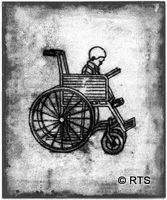 Using a set of 10 guiding questions we developed (Rethinking Schools 2009), we decided to explore ableist stereotypes in winners of the Caldecott Medal, which is awarded annually to “the most distinguished American picture book for children.” Caldecott winners are often endorsed by schools and libraries, and therefore purchased by many families. Unlike books intended for older audiences, picture books rely heavily on visual art to convey meaning. Children can read these picture books on their own; they don’t necessarily have meanings mediated by an adult. Books with the Caldecott seal may provide children with their first impressions of our diverse society. What hidden messages will they learn about disability?
Using a set of 10 guiding questions we developed (Rethinking Schools 2009), we decided to explore ableist stereotypes in winners of the Caldecott Medal, which is awarded annually to “the most distinguished American picture book for children.” Caldecott winners are often endorsed by schools and libraries, and therefore purchased by many families. Unlike books intended for older audiences, picture books rely heavily on visual art to convey meaning. Children can read these picture books on their own; they don’t necessarily have meanings mediated by an adult. Books with the Caldecott seal may provide children with their first impressions of our diverse society. What hidden messages will they learn about disability?
1. Does the book promote ableism by ignoring people with disabilities?
Sometimes what is not present in a book is as important as what is included. For example, So You Want To Be President? makes no mention of disability in any of the U.S. presidents. After contracting polio at age 39, well before he became president, Franklin Delano Roosevelt was never able to move or stand again without the assistance of a wheelchair, braces, or another person. Yet So You Want To Be President? fails to depict or acknowledge his disability.
Download the full article on the Rethinking Schools website.
![]()







Twitter
Google plus
LinkedIn